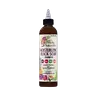What's inside
What's inside
 Key Ingredients
Key Ingredients

 Benefits
Benefits

 Concerns
Concerns

 Ingredients Side-by-side
Ingredients Side-by-side

Water
Skin ConditioningSodium Laurylglucosides Hydroxypropylsulfonate
CleansingCocamidopropyl Hydroxysultaine
CleansingDisodium Laureth Sulfosuccinate
CleansingCocamidopropylamine Oxide
CleansingSodium Chloride
MaskingDimethyl Lauramine
Vitis Vinifera Seed Oil
EmollientParfum
MaskingPEG-150 Pentaerythrityl Tetrastearate
EmulsifyingPhenoxyethanol
PreservativePPG-2 Hydroxyethyl Cocamide
EmulsifyingGlycerin
HumectantDimethyl Lauramide/Myristamide
EmulsifyingAloe Barbadensis Leaf Extract
EmollientGlycol Distearate
EmollientCocamidopropyl Betaine
CleansingTetrasodium EDTA
Laureth-4
EmulsifyingCocos Nucifera Fruit Extract
EmollientIodopropynyl Butylcarbamate
PreservativeMaltodextrin
AbsorbentCitric Acid
BufferingPotassium Sorbate
PreservativeCyclodextrin
AbsorbentAscorbic Acid
AntioxidantSodium Sulfite
PreservativeSimmondsia Chinensis Seed Oil
EmollientSodium Benzoate
MaskingAcetic Acid
BufferingWater, Sodium Laurylglucosides Hydroxypropylsulfonate, Cocamidopropyl Hydroxysultaine, Disodium Laureth Sulfosuccinate, Cocamidopropylamine Oxide, Sodium Chloride, Dimethyl Lauramine, Vitis Vinifera Seed Oil, Parfum, PEG-150 Pentaerythrityl Tetrastearate, Phenoxyethanol, PPG-2 Hydroxyethyl Cocamide, Glycerin, Dimethyl Lauramide/Myristamide, Aloe Barbadensis Leaf Extract, Glycol Distearate, Cocamidopropyl Betaine, Tetrasodium EDTA, Laureth-4, Cocos Nucifera Fruit Extract, Iodopropynyl Butylcarbamate, Maltodextrin, Citric Acid, Potassium Sorbate, Cyclodextrin, Ascorbic Acid, Sodium Sulfite, Simmondsia Chinensis Seed Oil, Sodium Benzoate, Acetic Acid
Ingredients Explained
These ingredients are found in both products.
Ingredients higher up in an ingredient list are typically present in a larger amount.
Parfum is a catch-all term for an ingredient or more that is used to give a scent to products.
Also called "fragrance", this ingredient can be a blend of hundreds of chemicals or plant oils. This means every product with "fragrance" or "parfum" in the ingredients list is a different mixture.
For instance, Habanolide is a proprietary trade name for a specific aroma chemical. When used as a fragrance ingredient in cosmetics, most aroma chemicals fall under the broad labeling category of “FRAGRANCE” or “PARFUM” according to EU and US regulations.
The term 'parfum' or 'fragrance' is not regulated in many countries. In many cases, it is up to the brand to define this term.
For instance, many brands choose to label themselves as "fragrance-free" because they are not using synthetic fragrances. However, their products may still contain ingredients such as essential oils that are considered a fragrance by INCI standards.
One example is Calendula flower extract. Calendula is an essential oil that still imparts a scent or 'fragrance'.
Depending on the blend, the ingredients in the mixture can cause allergies and sensitivities on the skin. Some ingredients that are known EU allergens include linalool and citronellol.
Parfum can also be used to mask or cover an unpleasant scent.
The bottom line is: not all fragrances/parfum/ingredients are created equally. If you are worried about fragrances, we recommend taking a closer look at an ingredient. And of course, we always recommend speaking with a professional.
Learn more about ParfumWater. It's the most common cosmetic ingredient of all. You'll usually see it at the top of ingredient lists, meaning that it makes up the largest part of the product.
So why is it so popular? Water most often acts as a solvent - this means that it helps dissolve other ingredients into the formulation.
You'll also recognize water as that liquid we all need to stay alive. If you see this, drink a glass of water. Stay hydrated!
Learn more about Water